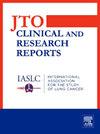新一代测序鉴定肺癌患者MET外显子14跳变的格局
IF 3.5
Q2 ONCOLOGY
引用次数: 0
摘要
在约0.9%至4%的NSCLC患者中观察到met外显子14 (METex14)跳变。本研究旨在比较基于dna的下一代测序(NGS)与基于捕获的文库构建和同步基于dna和rna的NGS与基于扩增子的文库构建在中国肺癌患者中METex14跳跃性的检出率。方法从11330例中国肺癌患者中抽取11330份组织样本,证实METex14跳变的存在。同时对30例患者进行MET免疫组化检测。结果基于扩增子文库构建的同步DNA和rna NGS中,METex14跳脱检出率最高,达2.20%。在DNA水平上共检测到45种不同的导致METex14跳变的变异。这些变异广泛分布在197个碱基对的DNA序列中。在总体人群中,60岁及以上人群中METex14跳脱的发生率显著较高(p <;0.0001)和针活检样本(p <;0.0001),与性别和肿瘤位置无显著关联。微卫星不稳定性高与METex14跳变呈正相关(p <;0.0001)。结论引起METex14跳变的突变具有多样性,广泛分布于不同的基因组区域。基于dna和rna的同步NGS被认为是检测METex14跳变的最佳方法。此外,METex14跳变在特定人群中丰富,包括60岁及以上的晚期疾病个体和微卫星不稳定-高状态。本文章由计算机程序翻译,如有差异,请以英文原文为准。
The Landscape of MET Exon 14 Skipping Mutations in Patients With Lung Cancer Identified by Next-Generation Sequencing
Introduction
MET exon 14 (METex14) skipping mutations are observed in approximately 0.9% to 4% of patients with NSCLC. This study aimed to compare the detection rates of METex14 skipping in Chinese patients with lung cancer using DNA-based next-generation sequencing (NGS) with capture-based library construction and synchronous DNA-based and RNA-based NGS with amplicon-based library construction.
Methods
A total of 11,330 tissue samples from 11,330 Chinese patients with lung cancer were included in the study to confirm the presence of METex14 skipping. Simultaneously, MET immunohistochemistry testing was performed on 30 patients.
Results
The highest detection rate of METex14 skipping was observed in the synchronous DNA and RNA-based NGS with amplicon-based library construction, reaching 2.20%. A total of 45 different variants leading to METex14 skipping were detected at the DNA level. These variants were widely distributed across a 197–base pair DNA sequence. In the overall population, the incidence of METex14 skipping was significantly higher in individuals aged 60 years and above (p < 0.0001) and needle biopsy samples (p < 0.0001) and reported no significant association with gender and tumor location. A positive correlation was observed between microsatellite instability–high and METex14 skipping (p < 0.0001).
Conclusions
The mutations causing METex14 skipping exhibit diversity in terms of variant types and are widely distributed across various genomic regions. Synchronous DNA-based and RNA-based NGS is considered the optimal method for detecting METex14 skipping. Furthermore, METex14 skipping is enriched in specific populations, including individuals aged 60 years and above, with advanced-stage disease and a microsatellite instability-high status.
求助全文
通过发布文献求助,成功后即可免费获取论文全文。
去求助
来源期刊

JTO Clinical and Research Reports
Medicine-Oncology
CiteScore
4.20
自引率
0.00%
发文量
145
审稿时长
19 weeks
 求助内容:
求助内容: 应助结果提醒方式:
应助结果提醒方式:


